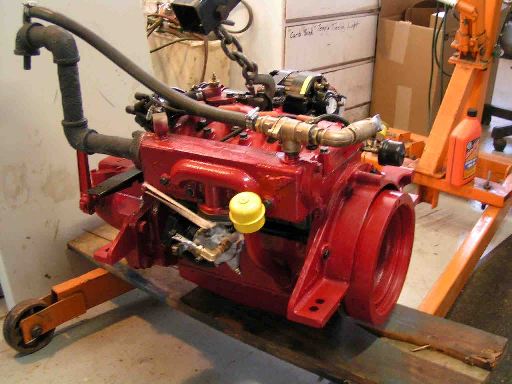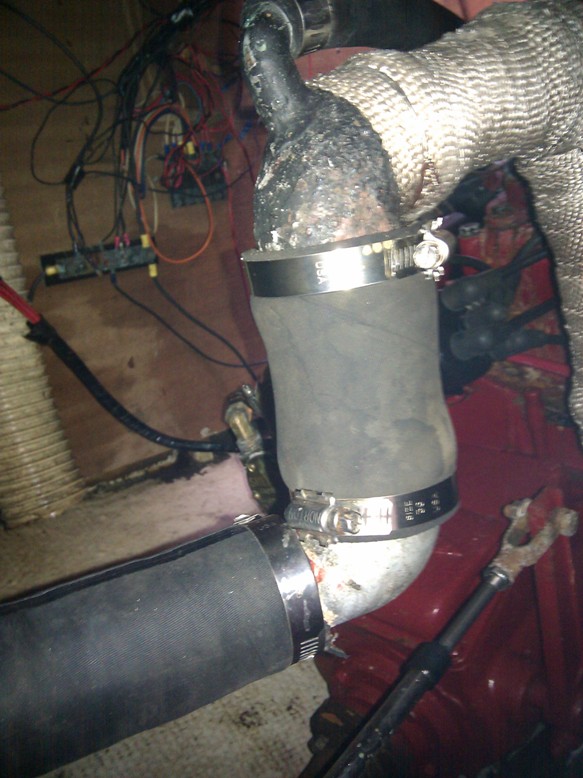| Author |
Message |
    
Chip G
Member
Username: chipg_98
Post Number: 9
Registered: 10-2005
| | Posted on Sunday, April 29, 2012 - 10:36 pm: | 




|
My rebuilt P-60 is running great! Prior to rebuild, I used the engine for about 6 years myself and have no idea how long it was used by others prior to that. Based on what I saw during the rebuild, I am guessing that it may not have ever been rebuilt before.
Generally same exhaust configuration before and after. Water lift muffler - side in - top out. Boatyard replaced deteriorated hull valve at exhaust through-hull with a straight connection with no through-hull valve. Appears to be pretty much the same flow path as prior to the change as far as I can tell.
I never had any problem at all with the exhaust hoses overheating prior the rebuild. Now I am seeing major overheating of the short piece of hose that is vertical and attached to the exhaust pipe just below the goose-neck at the mixer. Plenty of water is spraying out the exhaust through-hull while the engine is running. However, the exhaust hose (about 6 inches long mounted between the metal exhaust pipe and the elbow joint before entry in to the muffler via another approximately 12 inch hose) is definitely overheating... often after 10-20 minutes of engine run. Just to be clear, it is the 6 inch hose which is vertical between the exhaust pipe and the elbow joint that is overheating.
Any ideas? |
    
Chip G
Member
Username: chipg_98
Post Number: 10
Registered: 10-2005
| | Posted on Monday, May 14, 2012 - 01:05 am: | 




|
Still trying to figure this one out. I have attached a photo of the engine including the exhaust point where the rubber hose is now attached. Do you see anything that would lead you to concern in the configuration? I am stumped. Advice? |
    
Chip G
Member
Username: chipg_98
Post Number: 11
Registered: 10-2005
| | Posted on Monday, May 14, 2012 - 01:23 am: | 




|
Here is a detail of the connection with the hose mounted.
 |
    
kevin stone
Advanced Member
Username: kdstone
Post Number: 45
Registered: 01-2009
| | Posted on Wednesday, May 16, 2012 - 07:05 pm: | 




|
Every pipe before the point where water is injected does get hot. Are you sure it is overheating? Our palmer has a waterlift muffler and I have wrapped the exhaust from manifold to water injection point with high temp muffler tape from Moyer marine. |
    
Chip G
Member
Username: chipg_98
Post Number: 12
Registered: 10-2005
| | Posted on Thursday, May 17, 2012 - 01:19 am: | 




|
Thanks for the comment Kevin. The indications I have seen are as follows:
1. After rebuild, I ran the engine for 4 - 20 minutes periods for a total of 1 hr 20 minutes of run time after reinstalling. The short section of hose ruptured dramatically and appeared to have been pretty substantially burned on the inside near the top down to the area of the rupture. That was the same piece of hose that I used for approximately 6 years prior to the re-build. It was standard wet exhaust hose with the metal banding inside.
2. Replaced the ruptured hose with the one in the photo which is supposedly wet exhaust hose too though it is not labeled the way my other one was so I am kind of wondering if that is the case. It definitely does not have the metal reinforcement the way the other one did.
3. Ran motor for approximately 15 minutes. I started to smell the odor of burning rubber and shut off the engine. Immediately after shutting off the motor, I looked carefully in the engine compartment to figure out where the smell might be coming from and noticed smoke wafting from the upper portion of the hose shown in the photo. It stopped smoking shortly thereafter... maybe a few minutes... I didn't think to measure it but I am guessing 5-10 minutes at the most... probably shorter. I have not run the engine since that time.
Thoughts? |
    
kevin stone
Advanced Member
Username: kdstone
Post Number: 46
Registered: 01-2009
| | Posted on Friday, May 18, 2012 - 01:23 pm: | 




|
My Guess is this. The water in injected in a straight line above your problematic rubber hose, traveling through the center without touching the hose hitting the metal elbow and exiting. His allows the hot pipe before the short section to heat up the rubber , no water splashes around to cool it down. I would suggest replacing the short bit with a metal nipple. Wrap it all with the high temp tape.
It's just a guess, and does not explain why you did not have the problem before
Kevin |
    
Chip G
Member
Username: chipg_98
Post Number: 13
Registered: 10-2005
| | Posted on Friday, May 25, 2012 - 06:51 pm: | 




|
What should the typical contact temperature on the exhaust pipe just outside the engine be when the engine is running as it should be? |
    
Matthew Lennarz
Member
Username: mlennarz
Post Number: 28
Registered: 06-2010

| | Posted on Friday, May 25, 2012 - 07:20 pm: | 




|
Although not measured with a thermo, I would guess that mine runs about 200 degrees right after the pipe attachs to the exhaust manifold. Can touch it briefly for about 1-2 seconds. I will be down there Sunday, and could measure with a thermo. |
    
Chip G
Member
Username: chipg_98
Post Number: 14
Registered: 10-2005
| | Posted on Saturday, May 26, 2012 - 09:31 am: | 




|
Thanks Kevin and Matt. I agree with your comments but can definitely confirm that the short hose is overheating. I pulled the one in the photo and found the inside severely burnt already. I am now trying a hose rated for 550F with spikes to 600F. Seems to be working so far. Not sure what's different now from pre-rebuild with regard to this issue but it must be much hotter at the joint now than before.
Matt, if convenient, I would be very interested to know temperature readings on yours. Contact readings at exit from engine, first joint from metal to rubber hose, and running temperature from temperature sender on engine. |


